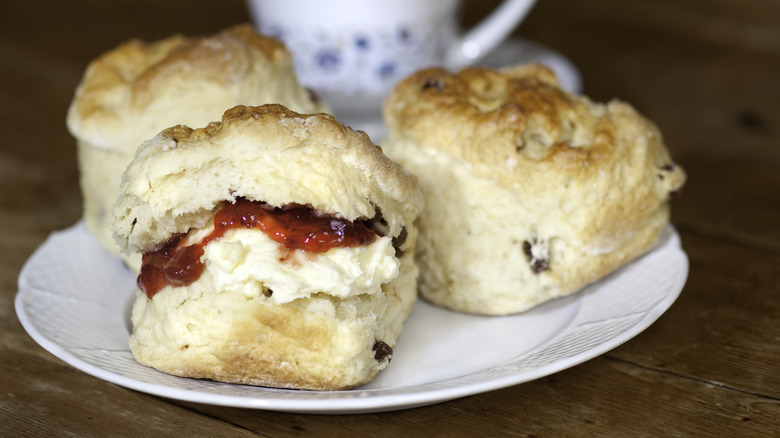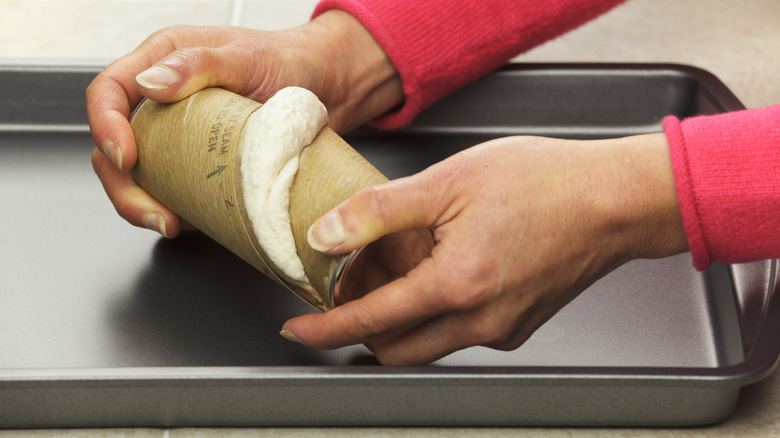Easily Transform Canned Biscuits Into Delicious Sweet Scones
A trip to your favorite coffee shop or a cozy morning just isn't complete unless you have something small to snack on while sipping a freshly brewed cup of joe. But the treat you choose is an important decision — something too big or heavy like a sandwich might spoil your next meal, while something extra sweet like a cake pop or a cookie might not feel like enough fuel. Next time you're contemplating what treat you truly need, consider whipping up a scone.
You might not have considered the biscuit-like pastry before because scones are usually synonymous with high-class afternoon tea and expensive bakeries — at least, that's the reputation they've earned in the U.S. What's more, the pastries are often regarded as too "hard" or "flavorless" to be enjoyable, neither of which is true. The key to a good scone is baking it properly, and the process doesn't have to be difficult. In fact, you can make delicious scones from a can of biscuit mix. Whether you have a can of Pillsbury homestyle buttermilk biscuits or a generic brand of flaky, layered biscuits in the back of your fridge, it only takes a few steps to transform them into sweet scones: just mix in additions like fruit or chocolate chips and add a glaze.
Transform any biscuit recipe into a batch of scones with a few key additions
You don't need a culinary degree or a ton of expensive ingredients to become a scone-making master — in a pinch, even a can of biscuit dough can become a batch of delicious scones. Adding in flavor and texture elements like dried fruit or chocolate chips to your biscuit dough can make this transformation simple. Once you've opened your can of biscuits, integrate your desired ingredients carefully, and be sure not to overmix, as this can lead to tough pastries. A scone isn't complete without a glaze drizzled over the top, which you can easily whip up with common pantry items. A buttermilk glaze will perfectly compliment the ingredients in the dough, or you can add a bit of citrus juice for elevated brightness.
This canned biscuit hack works best for sweet scones with the addition of things like fruit, chocolate, brown sugar, or other ingredients that will complement your biscuit dough's inherent sweetness. You may not want to use canned biscuit dough if savory scones are more your style, though. While biscuits and scones are extremely similar in ingredients, the amount of sugar in the pre-made dough might not be the exact balance of flavors your palate is looking for. Of course, it doesn't hurt to try, especially if you enjoy a hint of honey sweetness with something savory, like cheddar herb scones.
What separates a scone from a biscuit?
Just as fries are called chips and crackers are called biscuits, the U.K. has many different names for scones. Some visitors from across the pond may take one look at a buttermilk biscuit and claim it's a scone, while others know that there are a few key factors that determine whether or not your pastry concoction deserves the title of "scone." Most commonly, chefs and pastry lovers claim that a scone should be crumbly, whereas a biscuit is flaky. When trying to achieve ideal scone consistency, you'll need to take an extra-close look at your ingredients. While biscuits rely on buttermilk and, of course, butter to achieve their moist fluffiness, scones usually call for the addition of eggs when you're preparing them from scratch.
If you're all out of canned biscuits, you can still put together a batch of perfect scones using the dry ingredients listed in a biscuit recipe: flour, sugar, baking powder, and salt; just be sure to add an egg or two to your wet ingredients before mixing. To avoid overmixing, simply combine until you can form and cut the dough. If the mixture feels extra crumbly when you begin to form your scones, that means you're headed in the right direction.


